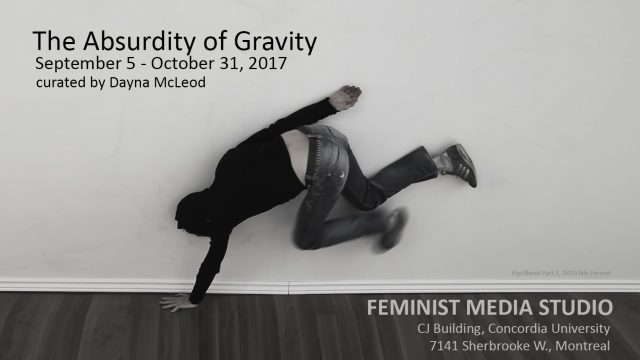
The Absurdity of Gravity
The Absurdity of Gravity
Curatorial statement
How do age, race, and gender affect how we see the body?
What do we encounter when artists perform stillness for the moving image?
How can collaboration be performed as a method of production and creation?
This video installation features work by Montreal media artist Nik Forrest. Their videos anchor this program, and are put in conversation with the work of three other artists to create a slowed down, call and response to address these questions. All of the works selected for this program have been chosen for how these artists stage their own body and/or other bodies for their lens and share with us the results, reflecting their definitive control of the camera’s gaze. Self-portraits in disguise, these works also demonstrate how gravity allows bodies to move in place and space while restricting the shape this movement takes, and the efforts these artists attempt to thwart this inescapable force.
Nik Forrest tests the boundaries of perception, gravity, and the absurd in their video works showcased in this program. In this series, Forrest collaborates with dancer Sarah Williams to improvise actions to “destabilize normal perception” of what is possible for bodies to do when it comes to the physics of gravity. Interested in creating uncertainty and instability in perception and potential, this series also highlights the importance of presence, the value of stillness, and the generative potential of failure.
In contrast and comparison to Forrest’s studio environment where gravity is manipulated and challenged through the absurd and banal, Carol Fernandes, soJin Chun, and Anne Parisien reveal their approach to how bodies maneuver gravity, stillness, place, and the pastoral. These works remind us of key elements that keep us grounded: the sky, the horizon, and the architecture of everyday life. Hiding in plain sight, soJin Chun uses her body to <try> to blend into her surroundings in Treasure Hill Camouflage. Here, Chun utilizes the militarized concept of camouflage to disguise her Korean identity as both critique and tactic, which enables her to ‘pass’ as Chinese or Taiwanese in the Treasure Hill village, where this video takes place. Carol Fernandes posits the body alongside the familiarity of bridges to create a tension between them in Holding On Like A Bridge. Her in-studio snapshot body part poses are evocative of Forrest’s work, and ground us as dizzying travel shots of a green bridge pair with this body in split screen. Using nostalgia and family-based collaboration as a method of performance, Anne Parisien recreates and reinterprets a banal childhood event in L’arbre. This work points to the absolute failure to acutely and accurately reproduce memories and moments from childhood, while reflecting similar Internet trends and production practices.
This program is curated from the collection of media works at Groupe Intervention Vidéo (GIV), a feminist video production and distribution artist-run centre in Montreal.
Comments are closed, but trackbacks and pingbacks are open.